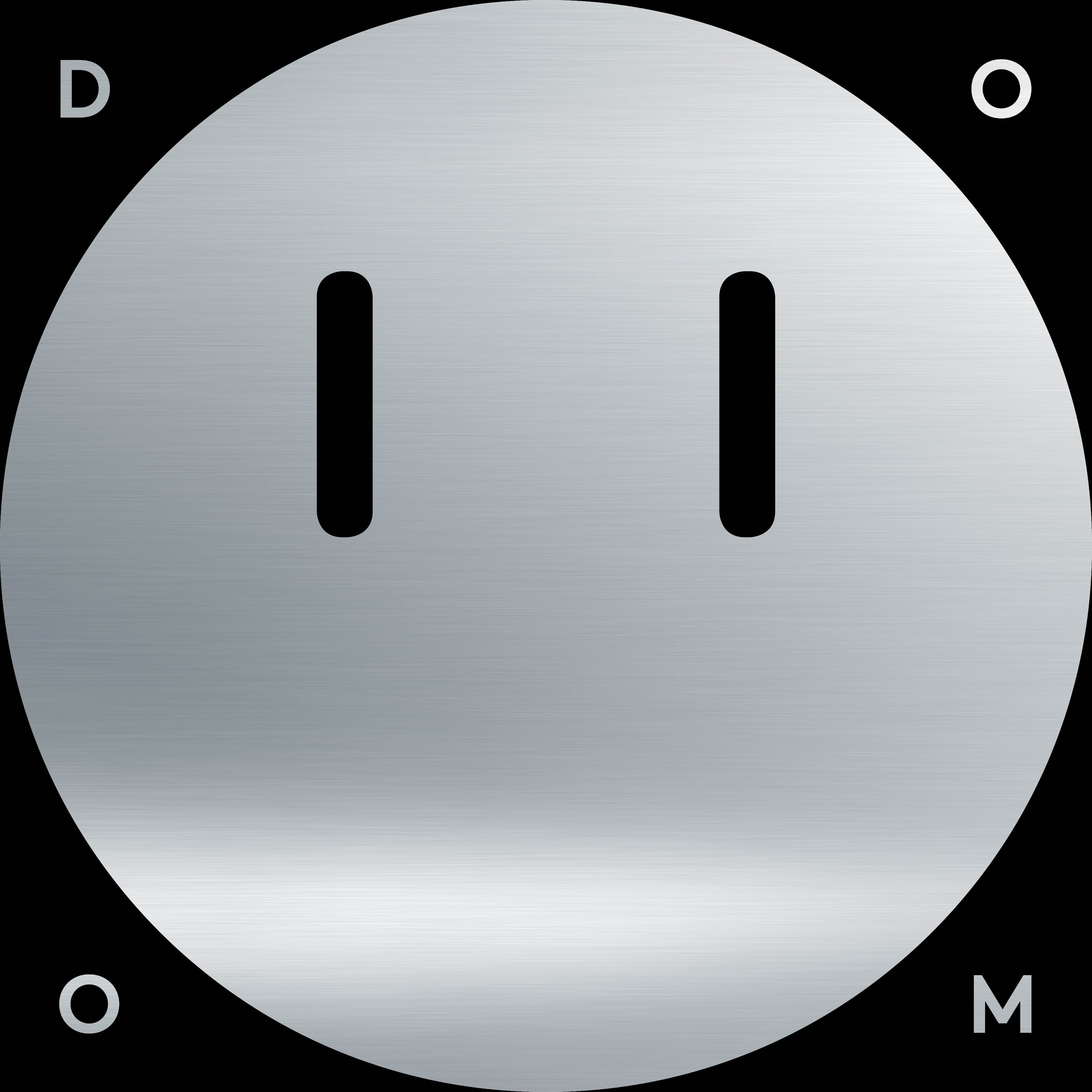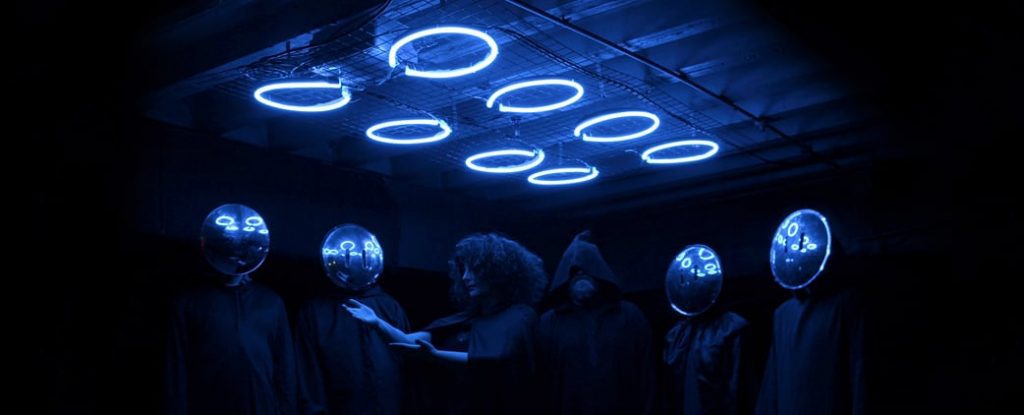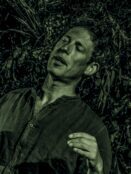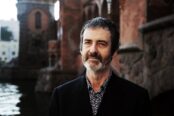[dropcap style=”font-size:100px;color:#992211;”]S[/dropcap]imon Jeffes once described the music of Penguin Café Orchestra as an imagining of the sort of folk music that might arise out of a dystopian future. In such a place people might get together and find a sort of omni-ethnic mode of expression, fusing a variety of cultures, harmonies and melodies to create something collective and yet distinct to the participants.
Bonnacons of Doom are in some sense attempting to describe the same vision. Incorporating several bombastic contemporary genres, their aim is to transcend those confines and tap into something universal. In the same future landscape that Jeffes’ group might find themselves creating a post-factory barn dance on the banks of the Mekon, the Bonnacons and their acolytes might congregate in the burnt-out remains of worker housing on the outskirts of Birmingham. In both cases we see people taking the edges of given cultures and refilling them with meaning.
“The abandonment to the moment, the fucked-up, out-of-control perfection of giving yourself over to the absolute now. Those are the feelings that were formative in our relationship to music and that’s what we’re always chasing when we’re playing.” – Rob, Bonnacons
 Bonnacons started as a performance art group, improvising music at happenings across the North of England. From their inception the Bonnacons were about creating site-specific experiences that connect audiences with their surroundings in deep ways: illuminated noise works overlaid with spy transmissions or stranger things, and each time unique. They are neither precious about fame (they wear masks) or even their line-up; various conglomerations of Bonnacons exist at any time though given a slightly different name for each outing. Bonnacons of Joy, Bonnacons of Light (electronic), of Dust (post-industrial) and in their full band psyche outing as the Bonnacons of Doom. Given that they weren’t really into capturing something for posterity from their onset the success of their recording has come as something of a happy surprise.
Bonnacons started as a performance art group, improvising music at happenings across the North of England. From their inception the Bonnacons were about creating site-specific experiences that connect audiences with their surroundings in deep ways: illuminated noise works overlaid with spy transmissions or stranger things, and each time unique. They are neither precious about fame (they wear masks) or even their line-up; various conglomerations of Bonnacons exist at any time though given a slightly different name for each outing. Bonnacons of Joy, Bonnacons of Light (electronic), of Dust (post-industrial) and in their full band psyche outing as the Bonnacons of Doom. Given that they weren’t really into capturing something for posterity from their onset the success of their recording has come as something of a happy surprise.
Sam (drums): “We didn’t plan to record anything originally; the main thing was to create these experiences. We weren’t thinking about creating something that had a recorded output. But then as the band part of the group grew we started to play more of a repeated set. That said when we get commissions we’ll look at how we can operate in a different way than the last show we did. It might be that a choir plays with us—in one instance there were about 17 of us on stage, on a very small stage. It was a very bad idea in some ways but then there’s a nice feeling to it where we can work out what will work best and there is a freedom to create a brand-new piece that’s maybe a one-off.
[On the other side of it] we are quite interested in doing free shows where we break down the boundaries of who might come; playing in cathedrals, public areas, etc., you know when people turn up and there are four or five people wearing cloaks and mirrored faces most people do stop and go, “What is this?” It is a bit of theatre.
Rob (guitar): In terms of the integration between music and theatre, Sam and I have been working on audiovisual projects for over a decade and that really informed what we did when it came to cohere as a band. We’ve also always been influenced by the idea of an AV experience. So, doing the mirrored masks and the capes is very much part of what we do. It’s not just a gig, it’s a full senses performance so it does have a cohesion with what we were doing before, which was more gallery or live art stuff.
Sounds like it’s becoming more of a concerted serious venture?
Sam: For sure, I mean it’s a bit of a surprise—oh yeah we have a record out now—but then we enjoy playing together and it’s an improvised performance at shows anyway. Even though we have tracks I feel like we bounce off each other and things morph during sets. It’s a physically intense thing for us. The fact that people are coming to see us is great even though in a way that was never the plan.
Do you see yourselves as part of the Goat and Master Musicians of Bukkake trend in ritual music?
Sam: We’ve been aware of that however we’ve never been exactly sure of how to describe our sound. We have certainly drifted into those circles but then we’re also aware that we’re all from the North of England and we’re very keen on folklore. In the past when we’ve done AV projects we’ve been guided by exploring the history of, say, Pendle [a site of historical witch trials], or from influences like experimental noise and heavy metal. Plus transpennine trance music of course, which goes back to our love of acid house and techno, so we get into the idea that there is a mantra or a zone of each track. A global approach to music that can be immersive, and since we’re not lyric-based, it’s much freer in that respect.
Rob: When we were starting to come together we wanted to get away from genre and make it interesting for ourselves. For instance the scales we’re using you could kind of say that they are non-Western, but it’s trying to push at the boundary of genre. Then as soon as Kate Smith came on with us as a vocalist she came with the sort of automatic vocal style working in modes and scales that were sort of non-Western, so in a way it came about quite naturally, even though we are of course aware of those acts. I don’t think it’s necessarily conscious. The way that we come together as an act, we want to transcend those boundaries as well as using elements that are not found in traditional rock music.
Sam: The various guises of Bonnacons, the beat-driven electronica, the band and the choir, all those are quite important to all of us. So that we’re trying to be in an area that we’re not totally familiar with. I’m not saying that we’re breaking boundaries but explore different elements of music-making, sound-making, art-making, experience-making; the point is to try and make it as open as possible to make it free for people (and us) to do that.
Other than the people involved, is there a consistent centre to the Bonnacon experience?
Sam: Yes, we’ve started a cult. [laughs]
Rob: But yes I suppose repetition, volume and ritualistic references bind it together because we are all interested in process, and process is an important thing in how people understand musicians. Especially when it becomes performative, because it’s then that it translates into something else. There is a connection between us as musicians that is facilitated by the idea of mantra and repetition is at the heart of it. We have very intense moments and feelings which take us out of ourselves in that process. That is really important to us and is really the core of what Bonnacons is about.
Bonnacons of Doom with PigsX7, Moth Club, 28 September SOLD OUT
Image: Andrew Ellis

Editor, founder, fan.




















